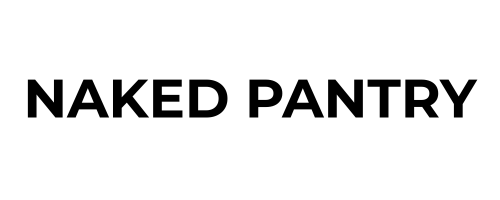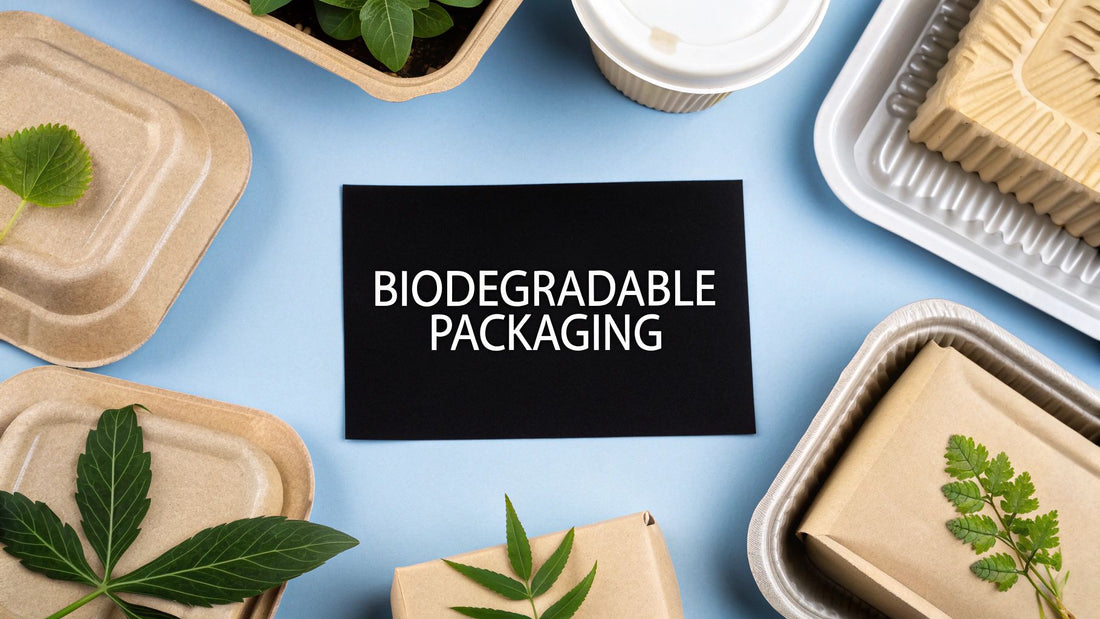
Top Biodegradable Packaging for Food – Eco-Friendly & Sustainable Solutions
Share
Protecting Our Planet, One Meal at a Time
Concerned about the environmental impact of plastic food packaging? This list showcases 8 innovative solutions: biodegradable packaging for food. Discover alternatives like mushroom packaging and seaweed wraps, moving us towards a plastic-free future. From Naked Pantry's zero-waste approach to compostable containers and films, explore these eco-friendly options and learn how to make more sustainable choices for your meals.
1. Naked Pantry: Revolutionizing Your Pantry with Biodegradable Packaging for Food
In a world increasingly aware of the detrimental effects of plastic pollution, finding truly sustainable food packaging solutions is paramount. Naked Pantry emerges as a promising solution, offering a revolutionary plastic-free subscription service that delivers pantry staples directly to your doorstep. By partnering exclusively with brands committed to compostable and reusable packaging, Naked Pantry is redefining how we access and consume everyday food items, making biodegradable packaging for food a practical reality. This commitment to sustainability addresses the growing concern of microplastics entering our food chain, offering a healthier and more environmentally conscious alternative to conventional grocery shopping.
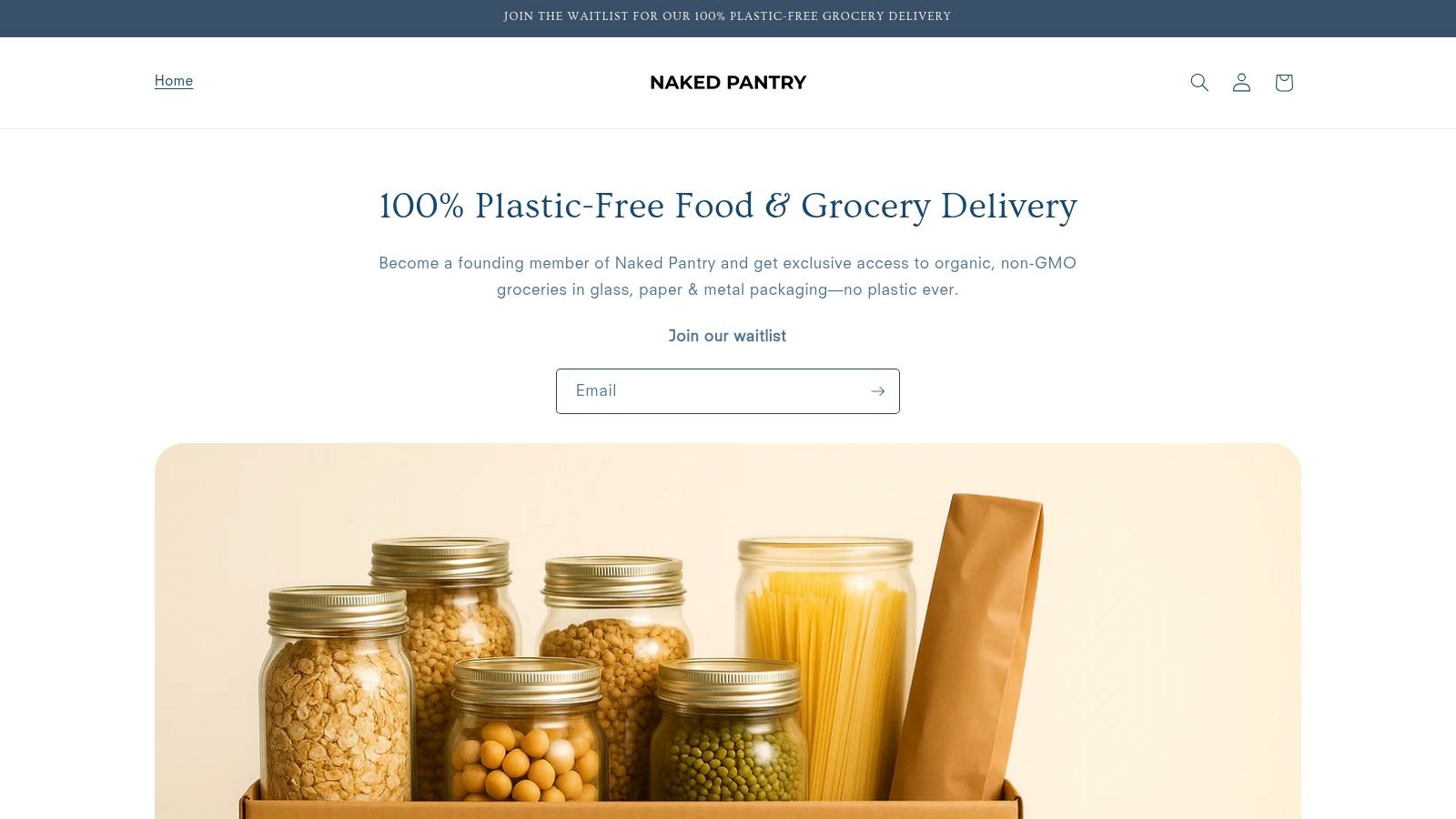
Naked Pantry distinguishes itself by focusing on the entire packaging lifecycle. From the sourcing of ingredients to the delivery to your home, plastic is completely eliminated. Instead, they utilize compostable paper, reusable glass jars, and durable metal tins. This comprehensive approach tackles the pervasive issue of plastic waste at its core, offering a tangible solution for individuals seeking to minimize their environmental footprint. This commitment extends beyond just the packaging; Naked Pantry emphasizes sourcing organic, Non-GMO, and whenever possible, U.S.-grown products. This focus on quality ingredients, combined with their sustainable packaging practices, aligns perfectly with the values of health-conscious consumers seeking both nutritional and environmental well-being.
The subscription service model simplifies access to these sustainably packaged goods. Instead of navigating crowded grocery store aisles filled with plastic-wrapped products, subscribers can conveniently receive curated selections of pantry staples delivered directly to their homes. This curated approach not only saves time but also ensures a consistent supply of ethically and sustainably sourced products. While similar zero-waste online stores exist, Naked Pantry stands out with its exclusive focus on pantry staples and its commitment to a completely plastic-free supply chain. Other services might offer some plastic-free options, but Naked Pantry takes it a step further by ensuring every element, from the product itself to the shipping materials, is free from plastic.
One of the key advantages of using Naked Pantry is the significant reduction in exposure to harmful chemicals often found in conventional plastic packaging. BPA and phthalates, known endocrine disruptors linked to various health issues, are completely avoided. Furthermore, by eliminating plastic, Naked Pantry directly combats the growing concern of microplastic contamination in our food and water supply. This focus on health and well-being resonates with individuals practicing functional medicine, following naturopathic principles, or simply striving for a cleaner, healthier lifestyle.
Implementing Naked Pantry into your routine is straightforward, though currently limited by a waitlist system. Interested individuals can join the waitlist on their website to become founding members and gain early access to the service. While specific pricing details are not yet publicly available, the emphasis on premium, organic, and sustainably sourced products suggests a higher price point than conventional grocery shopping. However, the long-term health and environmental benefits, coupled with the convenience of a subscription service, make it a compelling option for those prioritizing sustainability and well-being. It's recommended to inquire directly with Naked Pantry for specific pricing information once access is granted.
For those committed to biodegradable packaging for food and reducing their environmental impact, Naked Pantry presents a powerful solution. While the waitlist and lack of publicly available pricing information may be temporary drawbacks, the core offering – a 100% plastic-free supply chain for essential pantry staples – makes it a valuable resource for eco-conscious consumers. By choosing Naked Pantry, individuals can actively participate in reducing the estimated 40 million tons of annual plastic waste, while nourishing themselves with high-quality, ethically sourced food. This service caters specifically to the needs of those seeking a truly sustainable and health-conscious approach to grocery shopping, addressing a crucial need in the movement towards a more eco-friendly future. Visit https://www.nakedpantry.co to join the waitlist and explore this innovative solution for sustainable living.
2. PLA (Polylactic Acid) Food Containers
For businesses and individuals seeking truly biodegradable packaging for food, PLA (Polylactic Acid) containers stand out as a leading solution. Unlike conventional plastic derived from petroleum, PLA is crafted from 100% renewable plant-based resources. This typically includes corn starch, sugarcane, or potato starch, making it a significantly more sustainable choice. This shift towards renewable resources addresses growing concerns about the environmental impact of traditional plastics, aligning with the values of eco-conscious consumers seeking organic, clean-eating, and zero-waste lifestyles.
PLA containers offer an appealing combination of functionality and eco-friendliness. Their crystal-clear transparency provides excellent product visibility, crucial for showcasing fresh produce, salads, sandwiches, and bakery items. This clarity rivals that of traditional plastic containers, allowing businesses to maintain attractive food presentation while embracing sustainable practices. The rigid structure of PLA ensures durability and protection during transport and storage, safeguarding the quality of the food within. This makes them a practical choice for groceries, catering services, and restaurants committed to biodegradable packaging for food. Furthermore, PLA's competitive pricing makes it a viable option for businesses of all sizes looking to transition away from conventional plastics without a significant increase in packaging costs. Specific pricing varies depending on the supplier, size, and quantity ordered, and can often be found directly from manufacturers like NatureWorks (https://www.natureworks.com) or through various packaging distributors.
One of the key advantages of PLA is its compostability. These containers break down completely in industrial composting facilities within 90-180 days, returning to the earth as compost rather than persisting in landfills for centuries. This addresses a crucial concern for environmentally conscious individuals and businesses seeking to minimize their waste footprint. However, it's important to note that PLA requires industrial composting facilities for proper decomposition. Home composting or disposal in standard recycling bins will not yield the same results. This requirement underscores the importance of accessible industrial composting infrastructure and proper consumer education regarding disposal methods. Initiatives like composting programs in communities and partnerships between businesses and composting facilities are vital for realizing the full environmental benefits of PLA food packaging.
While PLA offers numerous advantages, it's crucial to be aware of its limitations. One key consideration is its heat resistance. PLA containers are suitable for cold and ambient temperature foods but have a limited heat tolerance of up to 140°F (60°C). This makes them unsuitable for packaging hot foods or liquids, which may warp or melt the container. Therefore, businesses offering hot meals or beverages would need to explore alternative biodegradable options. Similarly, PLA can become brittle in cold temperatures, potentially affecting its durability in certain storage or transportation scenarios. For example, if PLA containers are stored in freezing conditions, they may become more prone to cracking.
In comparison to other biodegradable packaging options like bagasse (sugarcane fiber) or molded fiber, PLA often offers superior clarity and a more rigid structure. Bagasse and molded fiber are excellent choices for certain applications, such as takeout containers or plates, but they may not provide the same level of transparency desired for displaying fresh produce or prepared meals. PLA’s rigidity also makes it more suitable for containing liquids compared to some other compostable materials. Understanding these differences allows businesses to choose the best biodegradable packaging for food based on their specific needs.
Implementing PLA food containers is relatively straightforward. They are readily available in various sizes and configurations, from clamshells for sandwiches and salads to containers for fruits, vegetables, and baked goods. When transitioning to PLA, it’s essential to clearly communicate its proper disposal method to consumers, emphasizing the need for industrial composting. Clear labeling on the packaging or informational signage at point-of-sale can help educate consumers and encourage participation in composting programs. For businesses, establishing partnerships with local composting facilities can streamline the disposal process and maximize the environmental benefits of using PLA food containers. This combination of sustainable packaging and responsible disposal practices contributes significantly to a more eco-friendly food system. By choosing PLA, businesses and individuals can actively contribute to a cleaner, more sustainable future while enjoying the practical benefits of this innovative packaging solution.
3. Bagasse Food Packaging
Bagasse food packaging presents a compelling solution for businesses and individuals seeking truly biodegradable packaging for food. Crafted from the fibrous residue left after sugarcane stalks are crushed for juice, this material offers a sustainable alternative to traditional petroleum-based options. This molded fiber packaging provides excellent insulation, making it suitable for a wide range of hot and cold food items. Its naturally grease and water-resistant properties, without the need for harmful chemical coatings, make it a standout choice for eco-conscious consumers and businesses. This renewable resource not only diverts agricultural waste from landfills but also offers a robust and functional packaging solution. For those prioritizing sustainability and minimizing environmental impact, bagasse emerges as a leading contender in the biodegradable packaging landscape.
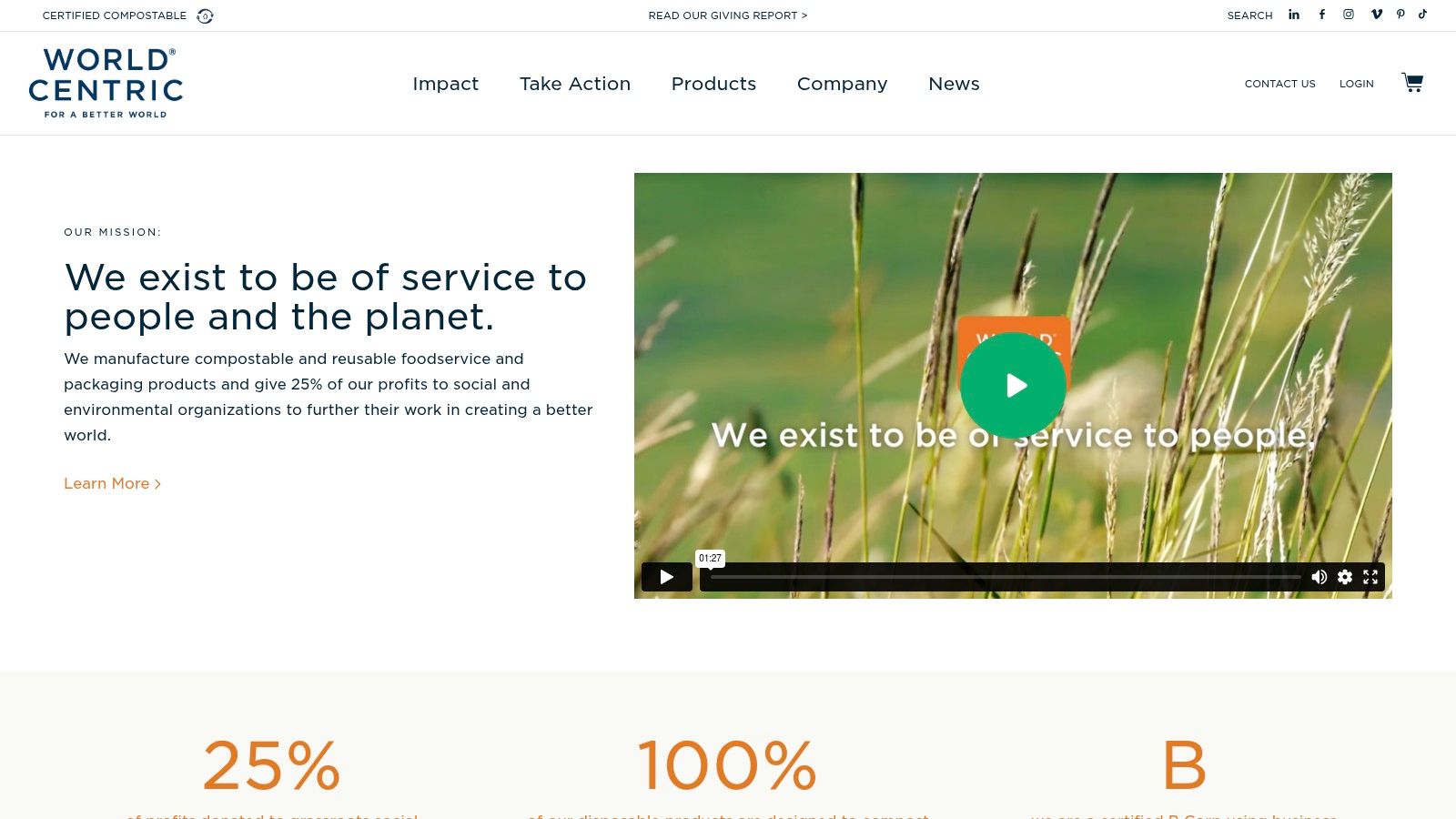
Bagasse packaging finds its niche in a variety of food service applications. From takeaway containers for hot meals like curries and stir-fries to cold dishes like salads and sandwiches, its insulating properties maintain optimal food temperatures. Its strength and lightweight construction make it suitable for single-use plates, bowls, and clamshells. Cafes, restaurants, food trucks, and catering services can benefit from using bagasse packaging to align with their sustainability goals and cater to the growing demand for eco-friendly options. Furthermore, its compostability makes it a valuable asset for businesses implementing closed-loop systems, reducing waste and promoting circular economy principles. Health-conscious consumers, particularly those focused on clean eating, organic foods, and zero-waste lifestyles, will appreciate the absence of harmful chemicals often found in conventional packaging. The natural composition of bagasse aligns with the principles of functional medicine, naturopathic practices, and the preference for non-GMO and naturally-sourced groceries.
One of the key advantages of bagasse food packaging is its utilization of agricultural waste material, contributing to a more sustainable approach to resource management. Its excellent insulation properties make it ideal for both hot and cold applications, eliminating the need for separate packaging solutions. Furthermore, the absence of chemical coatings caters to health-conscious consumers and minimizes environmental pollution. The strong and lightweight construction ensures durability while reducing transportation costs.
While bagasse offers numerous benefits, it also has some limitations. Design flexibility is somewhat restricted compared to plastic alternatives, which might impact branding and aesthetics. While naturally resistant to grease and water, extended exposure to liquids can eventually lead to absorption. Some users also report a slight natural odor initially, although this typically dissipates quickly. Finally, due to the natural material, color variations can occur between batches.
While precise pricing information isn't readily available and typically depends on order volume and specific requirements, bagasse packaging generally falls within a competitive price range compared to other biodegradable options. Companies like World Centric (https://www.worldcentric.com) specialize in bagasse food packaging and offer a range of products and customization options. Implementing bagasse packaging is straightforward, requiring no specific technical requirements beyond standard food handling procedures. However, proper storage is essential to prevent moisture absorption. Storing the packaging in a cool, dry environment is recommended.
Compared to other biodegradable options like PLA (polylactic acid) or bamboo, bagasse stands out for its superior insulation properties and readily available source material. While PLA offers greater design flexibility, its production requires more energy and resources. Bamboo, while also a renewable resource, often involves longer transportation distances. Bagasse, being a byproduct of sugar production, offers a more localized and readily accessible solution in many regions. By choosing bagasse food packaging, businesses and individuals can actively contribute to a more sustainable future while enjoying the benefits of a high-performing and eco-friendly packaging solution.
4. Mushroom-Based MycoComposite Packaging
In the quest for sustainable biodegradable packaging for food, an innovative solution is emerging from an unlikely source: mushrooms. MycoComposite packaging, crafted from the root structure of mushrooms known as mycelium, offers a remarkable alternative to traditional packaging materials. This unique material utilizes agricultural waste, effectively turning what was once considered refuse into a valuable resource. MycoComposite grows around the waste, binding it together to form custom-shaped protective packaging that’s entirely biodegradable and boasts excellent cushioning properties, making it ideal for safeguarding delicate food items.
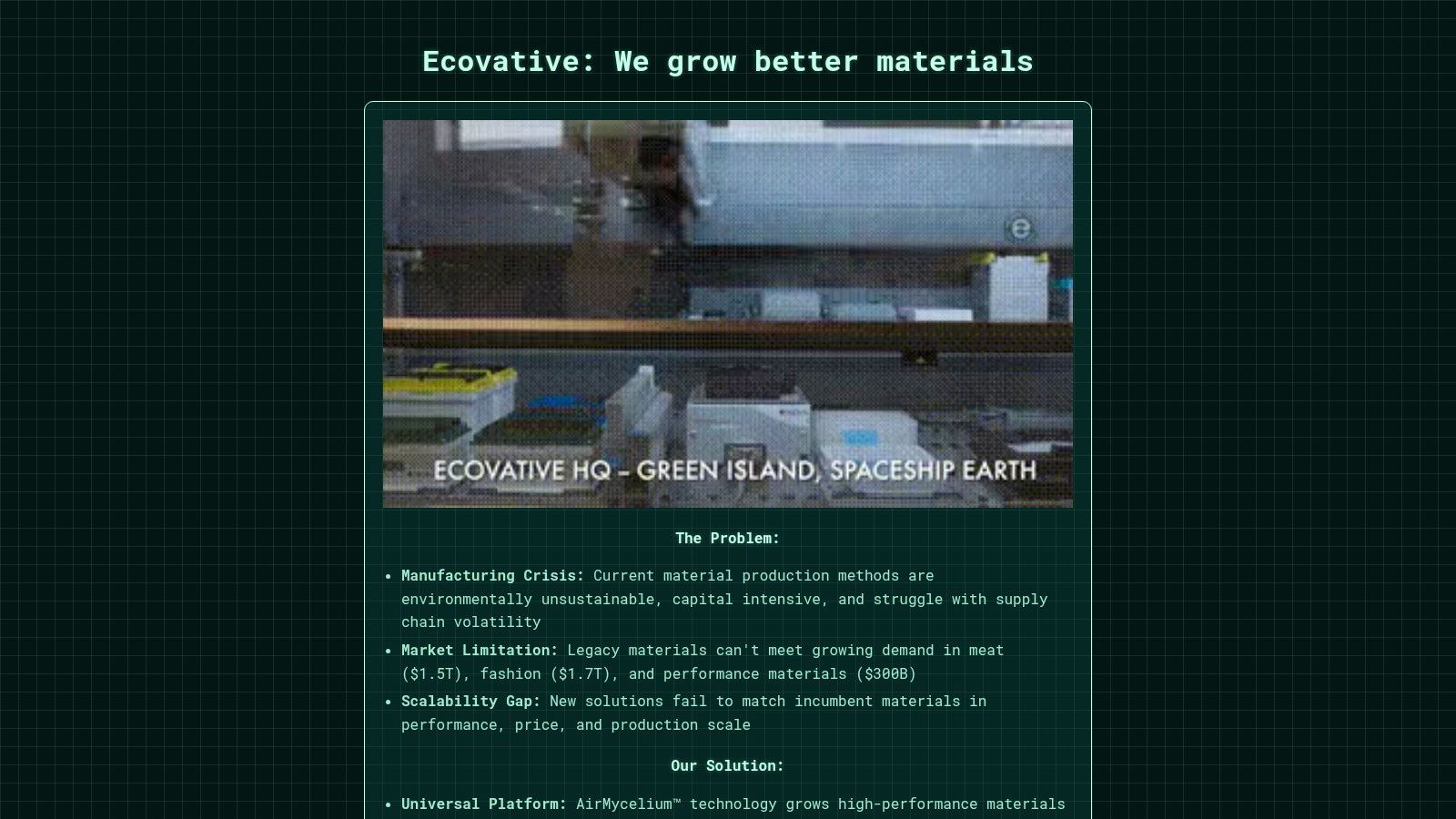
The process begins with agricultural waste, such as hemp hurds or straw, which is sterilized and inoculated with mushroom mycelium. Over several days, the mycelium grows and binds the agricultural waste together, forming a solid, lightweight structure. This structure can then be molded into virtually any shape required for the specific food product, providing a snug and protective fit. Once the desired shape is achieved, the material is dried and heat-treated to stop the mycelium from growing further. The result is a completely biodegradable packaging solution that’s both functional and environmentally friendly.
MycoComposite packaging presents a compelling option for businesses seeking biodegradable packaging for food due to its numerous advantages. Its custom-moldable nature makes it suitable for a wide variety of food products, from delicate fruits and vegetables to baked goods and specialty items. Imagine perfectly shaped packaging cradling heirloom tomatoes, cushioning fragile pastries, or protecting artisan cheeses. The natural antimicrobial properties of mycelium offer an added benefit, helping to extend the shelf life of food products and reduce spoilage. Further, its fire-resistant and insulating properties provide an extra layer of protection during transport and storage. And, perhaps most importantly for the eco-conscious consumer, MycoComposite is home compostable within 30-45 days, meaning it breaks down naturally without requiring specialized composting facilities.
This commitment to sustainability aligns perfectly with the values of those seeking organic, clean-eating, and zero-waste lifestyles. Individuals focused on functional medicine, naturopathic approaches, non-GMO products, and conscious grocery shopping will appreciate the natural and plastic-free composition of MycoComposite. It represents a significant step towards reducing reliance on petroleum-based plastics and embracing a more circular economy.
However, while MycoComposite holds immense promise, it's crucial to acknowledge its current limitations. The higher cost compared to traditional packaging materials can be a barrier for some businesses. Production capacity is also currently limited, which may lead to longer manufacturing lead times and potentially restrict availability. Furthermore, MycoComposite is not suitable for liquid food products due to its porous nature. These limitations highlight the ongoing development of this exciting technology and the need for further investment and innovation.
Compared to other biodegradable options like PLA (polylactic acid), which requires industrial composting facilities, MycoComposite's home compostability makes it a more accessible and practical choice for consumers and businesses alike. While materials like molded pulp offer some level of protection, MycoComposite’s custom-molding capabilities and antimicrobial properties provide superior performance for specific applications.
If you're considering implementing MycoComposite packaging, it’s important to plan ahead. Due to the longer lead times, factor this into your production schedule. Contact suppliers like Ecovative Design (https://www.ecovativedesign.com) to discuss your specific needs and product requirements. Explore the different molding options and consider how MycoComposite can best protect and enhance your product presentation. While pricing information isn't readily available, engaging directly with suppliers will provide you with tailored quotes.
MycoComposite packaging embodies the future of biodegradable packaging for food, offering a truly sustainable solution for eco-conscious businesses and consumers. As production capacity increases and costs decrease, this innovative material has the potential to revolutionize the food packaging industry and contribute significantly to a healthier planet.
5. Seaweed-Based Edible Food Wraps
Imagine a world where packaging disappears after use, leaving no trace behind. This isn't science fiction, but a reality being pioneered by innovative companies like NotPla, utilizing seaweed to create completely edible food wraps. This cutting-edge approach to biodegradable packaging for food offers a compelling solution to the global plastic pollution crisis, appealing to environmentally conscious consumers and businesses seeking truly sustainable alternatives. Seaweed-based packaging represents a radical shift, moving beyond simply compostable or recyclable to a product that eliminates waste entirely. These edible films and wraps, crafted from marine algae, offer a unique and sustainable way to protect and serve food.

These transparent, flexible wraps are made from renewable seaweed and algae, offering a natural barrier against moisture and oxygen, preserving the freshness of the food they encase. Unlike traditional plastic packaging, seaweed-based wraps are entirely safe for consumption, meaning they can be eaten along with the food or simply dissolved in water after use. This zero-waste approach aligns perfectly with the growing zero-waste movement and appeals to individuals committed to minimizing their environmental impact. They also offer a unique sensory experience, as the flavors and colors can be customized, opening exciting possibilities for culinary creativity. Imagine a subtly flavored wrap enhancing the taste of its contents, or a vibrant, naturally colored wrap adding visual appeal to a dish.
The practical applications for seaweed-based edible food wraps are vast and varied. They are particularly well-suited for single-serve portions of foods like sauces, condiments, snacks, and even individual servings of drinks. Think pre-portioned dressings for salads, small sachets of spices, or individual pods of water for marathon runners. They can also be used to wrap fresh produce, reducing the need for plastic films and containers in grocery stores. Restaurants can leverage this innovative packaging to present dishes in a novel and eco-friendly way, resonating with diners seeking sustainable dining experiences.
While the potential of this biodegradable packaging for food is immense, there are challenges to consider. Currently, the cost per unit is significantly higher than traditional packaging materials, making widespread adoption a hurdle. The shelf life of seaweed-based wraps is also limited, and they are sensitive to humidity and temperature fluctuations, requiring careful storage and handling. As the technology is still in its early commercial stages, production capacity and availability are limited. Companies like NotPla (https://www.notpla.com) are actively working on overcoming these challenges through research and development, scaling production, and exploring partnerships to expand market reach.
Compared to other biodegradable options like PLA (polylactic acid) derived from cornstarch, seaweed-based wraps offer the distinct advantage of being completely edible and dissolving in water, eliminating the need for composting infrastructure or specialized recycling streams. While PLA requires specific conditions for decomposition, often industrial composting facilities, seaweed wraps break down rapidly in any environment.
Implementing seaweed-based packaging into your business or lifestyle requires careful consideration. Due to its sensitivity to humidity and temperature, proper storage is critical. Dry, cool conditions are essential for maintaining the integrity of the wraps. Businesses exploring this option should partner closely with suppliers like NotPla to understand the specific handling requirements and shelf-life considerations. For consumers, understanding the limitations of the current technology is key. While not yet suitable for all food packaging applications, seaweed-based wraps offer a powerful symbol of a future free from plastic waste and represent a significant step toward a more sustainable food system. This innovative solution perfectly aligns with the values of the target audience – eco-friendly, sustainability-focused individuals seeking clean-eating options and a zero-waste lifestyle. By choosing seaweed-based packaging, consumers can actively participate in a circular economy, enjoying both the benefits of convenient packaging and the satisfaction of contributing to a healthier planet.
6. Wheat Straw Fiber Packaging: A Sustainable Solution for Food Packaging
In the quest for eco-friendly food packaging solutions, wheat straw fiber packaging emerges as a strong contender. This innovative approach utilizes agricultural waste from wheat harvesting, transforming what was once considered a byproduct into sturdy and biodegradable containers and plates. By employing natural binding processes, wheat straw packaging offers a durable and sustainable alternative to traditional plastic and Styrofoam, aligning perfectly with the principles of a circular economy. This makes it an excellent choice for eco-conscious consumers and businesses seeking biodegradable packaging for food.
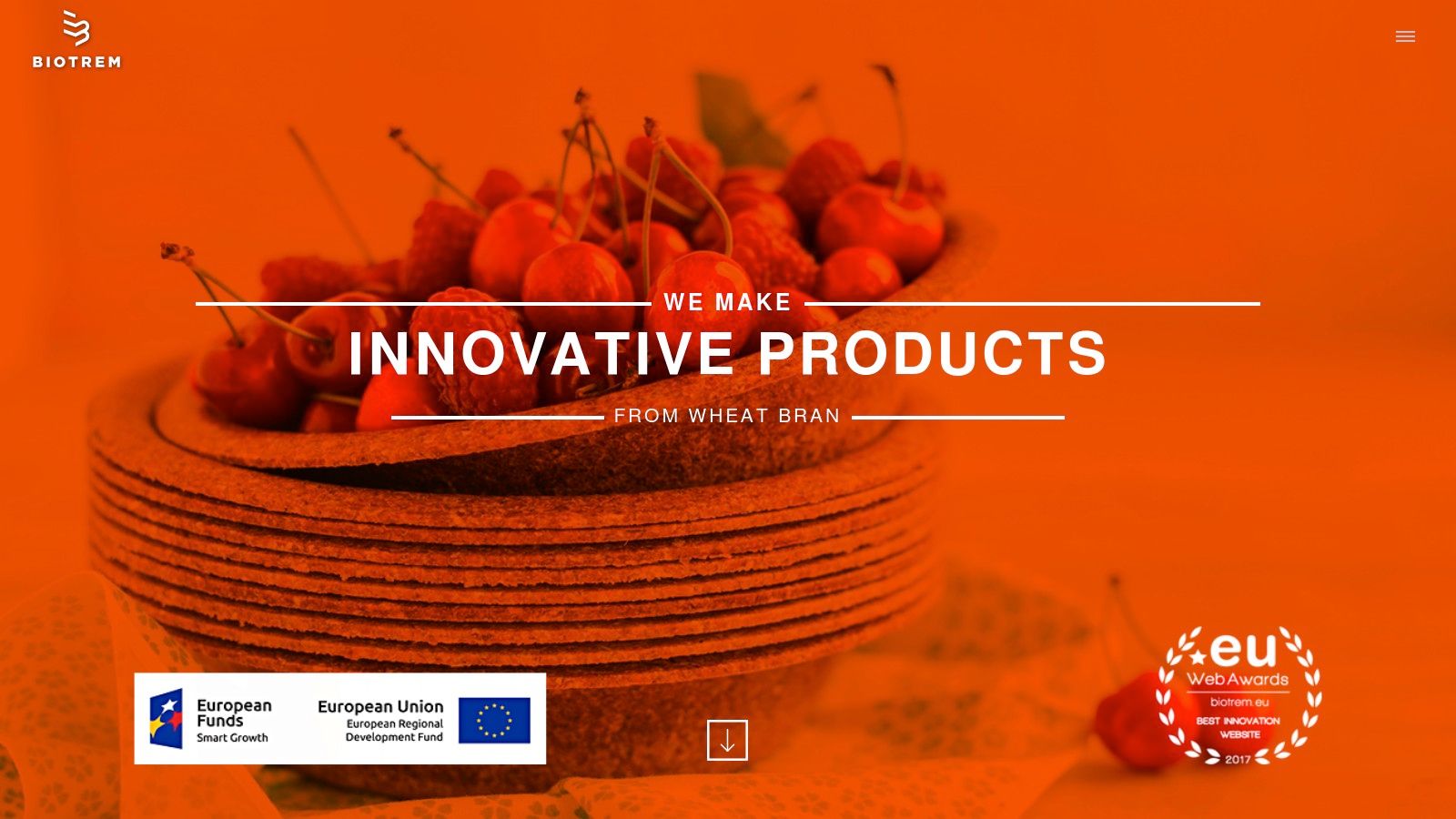
Wheat straw fiber packaging offers a compelling array of features that make it stand out in the world of sustainable food packaging. It is primarily made from agricultural wheat waste, effectively diverting this abundant resource from landfills or incineration. The manufacturing process uses natural binding agents, eliminating the need for synthetic glues and adhesives that can leach harmful chemicals into food. Furthermore, these containers are often dishwasher and microwave safe, providing the convenience of reusability and reheating. Perhaps most importantly, wheat straw fiber packaging is fully compostable, typically breaking down within 90-120 days in a home compost environment. It even boasts natural antibacterial properties, adding an extra layer of food safety.
This type of biodegradable packaging for food is particularly well-suited for a variety of applications. Takeout restaurants and food delivery services can utilize wheat straw containers for hot and cold dishes, reducing their reliance on single-use plastics. Caterers can opt for elegant wheat straw plates and bowls for eco-conscious events. Health food stores and grocery stores can package prepared foods and baked goods in these sustainable containers, appealing to their environmentally conscious clientele. Even for home use, storing leftovers or packing lunches in wheat straw containers offers a sustainable and healthy alternative.
Compared to other biodegradable options like bagasse (sugarcane fiber) or bamboo, wheat straw packaging often offers a more cost-effective solution due to the widespread availability of wheat waste. While bagasse and bamboo also provide excellent biodegradable alternatives, wheat straw's abundance and ease of processing contribute to its competitive pricing. However, it's important to note that pricing can fluctuate based on the manufacturer, order volume, and specific product design. Contacting suppliers like Biotrem (https://www.biotrem.pl) directly can provide more detailed pricing information and technical specifications.
While wheat straw packaging offers numerous advantages, it's essential to be aware of its limitations. The natural color of wheat straw limits color options, typically resulting in earthy, neutral tones. This can be a drawback for businesses looking for vibrantly colored packaging. Additionally, wheat straw can absorb strong odors, which may affect the taste or aroma of certain foods. It’s best to avoid packaging highly aromatic dishes in wheat straw containers. The material may also exhibit slight texture variations, which can be perceived as a rustic aesthetic or, conversely, as a lack of uniformity. Finally, wheat straw packaging is not completely transparent, making it less suitable for showcasing food products where visibility is key.
Implementing wheat straw packaging into your business or home is straightforward. Start by identifying the specific food packaging needs – containers for takeout, plates for events, or storage containers for home use. Then, research reputable suppliers like Biotrem and request samples to assess the quality and suitability of their products. Consider the size and shape requirements for your intended use. Factor in the limited color options and potential for odor absorption when choosing which food items to package. When transitioning to wheat straw packaging, clearly communicate the environmental benefits to your customers or family, highlighting the compostability and sustainable nature of the material. This can enhance brand perception and encourage wider adoption of eco-friendly practices. By understanding both the benefits and limitations of wheat straw fiber packaging, you can make informed decisions and contribute to a more sustainable future for food packaging.
7. PBAT/PBS Biodegradable Film Wrap
For businesses and consumers seeking truly compostable solutions for food packaging, PBAT/PBS biodegradable film wrap stands out as a viable alternative to conventional plastic films. This innovative material offers the flexibility and protective qualities of plastic while minimizing environmental impact through its biodegradability. PBAT (Polybutylene Adipate Terephthalate) and PBS (Polybutylene Succinate) are synthetic biodegradable polymers specifically engineered to decompose in composting environments. This makes them a compelling choice for eco-conscious food packaging, particularly for products like fresh produce, meats, and baked goods that require a secure and protective wrap.
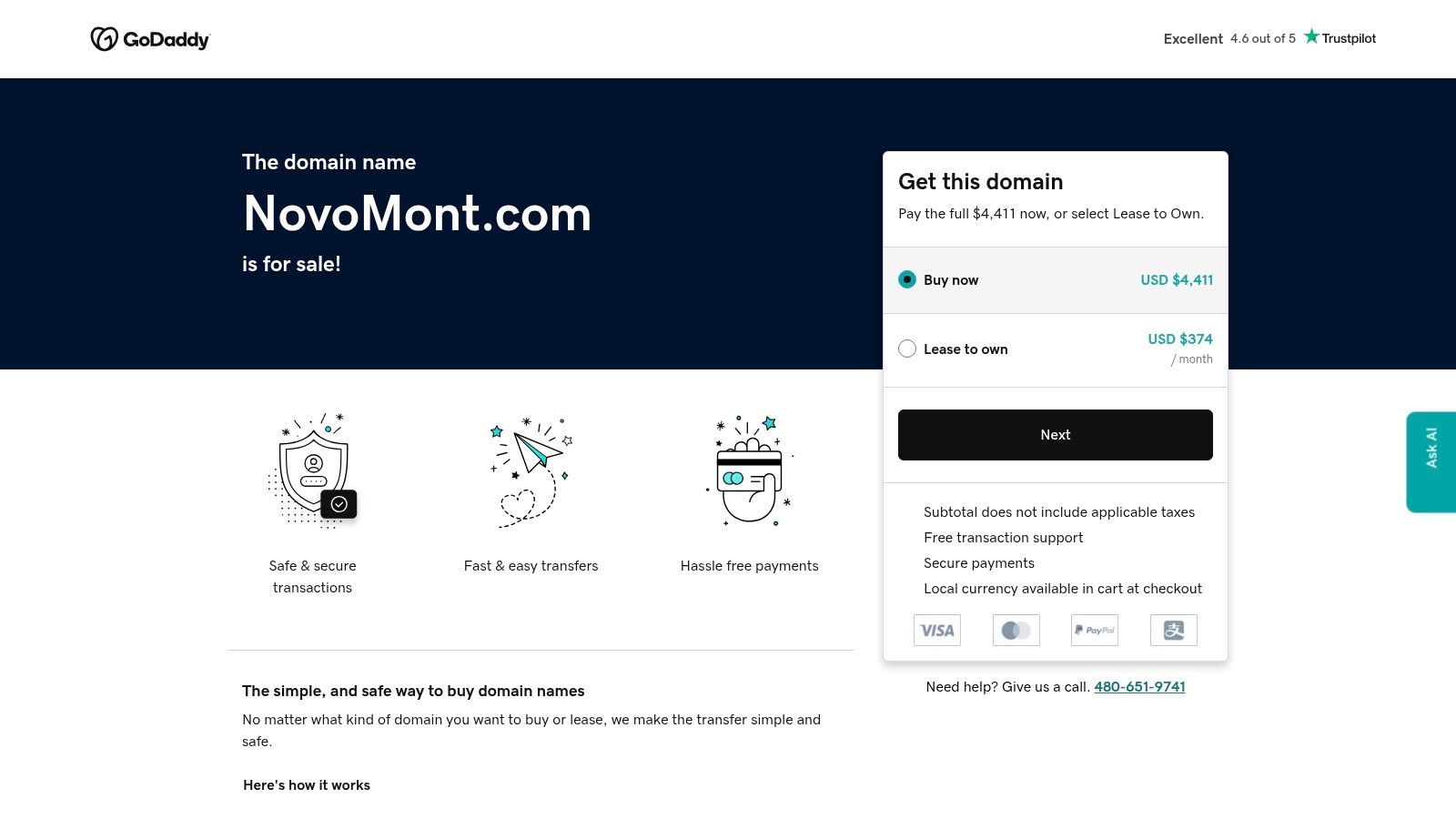
PBAT/PBS films excel in providing a high barrier against moisture and gases, preserving the freshness and quality of packaged food items. This is crucial for extending shelf life and minimizing food waste, a key concern for both consumers and businesses. Their excellent flexibility and stretch properties allow for easy wrapping and conforming to various product shapes, making them suitable for a wide range of food packaging applications. Moreover, these films are heat-sealable, ensuring secure closures and tamper-evident packaging, important features for maintaining food safety and preventing contamination.
One of the most significant advantages of PBAT/PBS films is their certified compostability. They meet stringent international standards such as EN 13432 and ASTM D6400, assuring consumers and businesses that the packaging will break down completely in industrial composting facilities. This contributes significantly to reducing plastic pollution and promoting a circular economy. While similar biodegradable options exist, such as PLA (Polylactic Acid) films, PBAT/PBS films generally offer superior flexibility and barrier properties, making them more suitable for demanding food packaging applications. PLA, for example, can be brittle and less resistant to moisture, limiting its use for certain food types.
However, it's important to acknowledge the limitations of PBAT/PBS films. A primary drawback is the higher cost compared to conventional plastics. This can pose a challenge for businesses looking to adopt sustainable packaging without significantly increasing their overall costs. Furthermore, while biodegradable, the raw materials for PBAT/PBS are currently petroleum-based. Though research into bio-based versions is ongoing, the current reliance on fossil fuels remains a concern for some environmentally conscious consumers. Finally, PBAT/PBS films require industrial composting facilities for proper decomposition. Home composting or disposal in regular landfills will not lead to biodegradation, highlighting the need for access to appropriate composting infrastructure.
Implementing PBAT/PBS film wrap into existing packaging systems is relatively straightforward, as it can be processed on conventional packaging equipment designed for plastic films. This makes the transition to biodegradable packaging more manageable for businesses. For smaller businesses or individuals exploring the use of PBAT/PBS films, pre-cut sheets or rolls are available from various suppliers, allowing for manual wrapping and sealing. Specific pricing information for PBAT/PBS films isn't readily available publicly as it varies depending on factors like order volume, film thickness, and specific supplier. Contacting manufacturers or distributors like Novomont (https://www.novomont.com) is recommended for detailed pricing and technical specifications.
For consumers seeking biodegradable food packaging options, looking for the EN 13432 or ASTM D6400 certifications on product labels ensures that the packaging is truly compostable. Supporting businesses that utilize these materials encourages wider adoption of sustainable packaging practices within the food industry. Despite the higher cost and the requirement for industrial composting, PBAT/PBS film wrap offers a significant step towards reducing plastic waste in the food sector and aligns with the values of eco-conscious consumers seeking healthier, more sustainable food choices. This positions PBAT/PBS film as a deserving entry in the list of top biodegradable packaging options for food, particularly for those prioritizing performance and compostability.
8. Palm Leaf Plates and Containers
For those seeking truly natural and aesthetically pleasing biodegradable packaging for food, palm leaf plates and containers offer a compelling solution. These eco-friendly alternatives are crafted from naturally fallen leaves of the Areca palm tree, eliminating the need for cutting down trees. Through a simple process of heat pressing and steaming, the leaves are molded into various shapes, creating durable and functional servingware. This process avoids the use of any chemicals or binding agents, resulting in a 100% natural and compostable product. This makes them a top choice for eco-conscious consumers and businesses committed to sustainable practices. They offer a unique rustic charm, bringing a touch of nature to any dining experience.
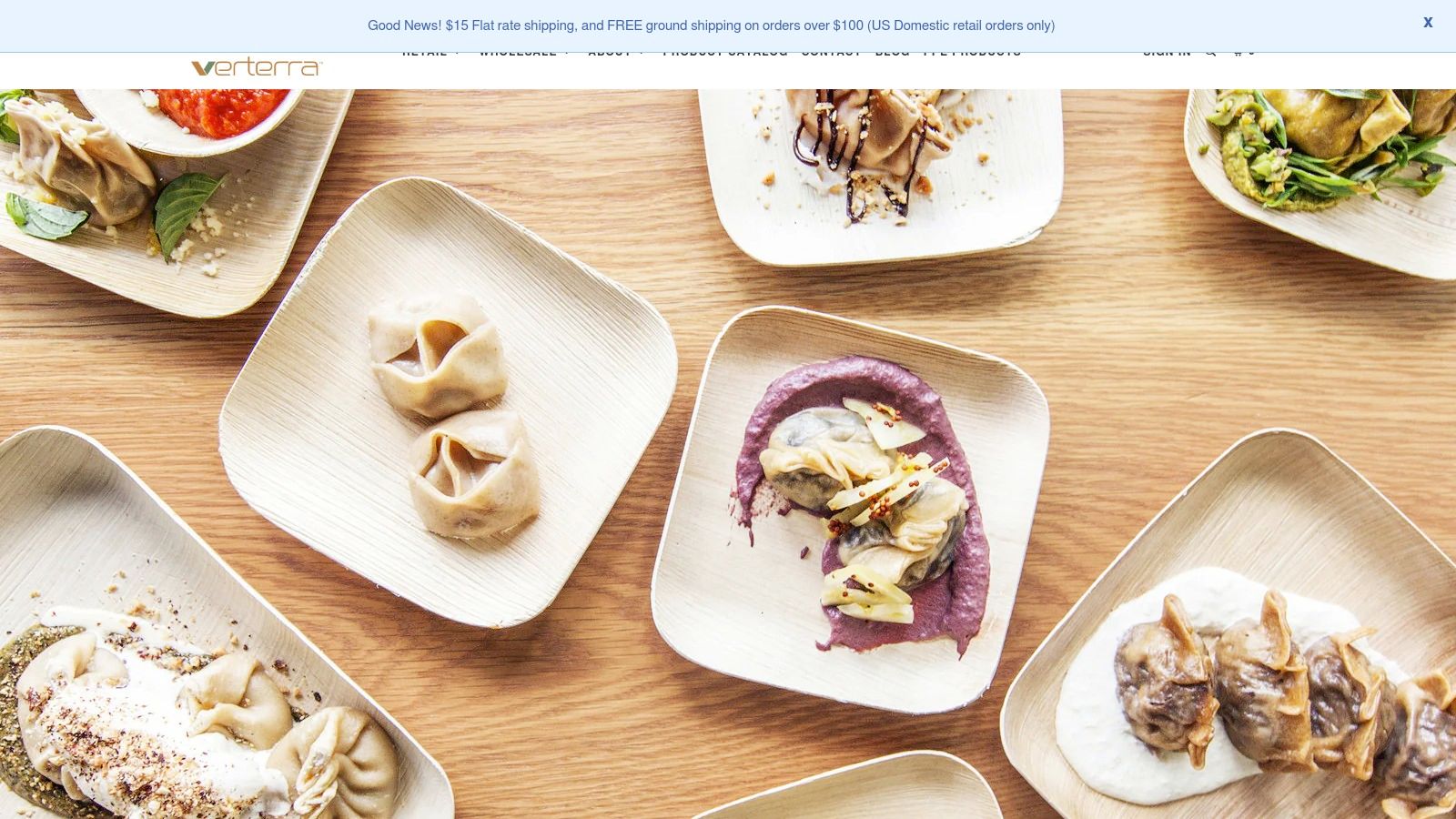
Palm leaf packaging excels in various food service applications. Their inherent strength and heat resistance make them suitable for both hot and cold dishes, from appetizers and entrees to desserts. They are a popular choice for outdoor events, picnics, and food trucks, offering a convenient and stylish alternative to traditional disposable tableware. Beyond their practical applications, palm leaf plates and containers contribute to a healthier planet. Their compostability means they break down naturally within 60-90 days, returning valuable nutrients to the soil, unlike conventional plastic packaging that persists for centuries. Choosing palm leaf products supports sustainable forestry practices as they utilize a renewable resource and avoid deforestation. This resonates strongly with consumers who prioritize organic, zero-waste, and eco-living principles.
While specific pricing details can vary depending on supplier and order volume, palm leaf products generally fall within a competitive price range compared to other biodegradable packaging options. The seasonal availability of palm leaves can influence pricing, with potential fluctuations throughout the year. It's advisable to contact suppliers like Verterra (https://www.verterra.com) directly for current pricing and bulk order options. Regarding technical requirements, palm leaf packaging is naturally sturdy and requires no special handling or storage conditions. However, due to their natural composition, they are not suitable for holding liquid foods without the use of liners. This is an important consideration for businesses serving soups, stews, or other liquid-based dishes.
Compared to similar biodegradable options like sugarcane bagasse or bamboo, palm leaf offers a distinct aesthetic appeal with its unique natural patterns and textures. While bagasse products often have a smoother, more uniform appearance, palm leaf retains the natural grain and texture of the leaf, giving it a rustic and handcrafted feel. Bamboo, while also a sustainable resource, can sometimes have a slightly higher price point than palm leaf. The choice between these options often comes down to personal preference and the specific needs of the application.
Implementing palm leaf packaging into your food service operation is straightforward. They can be used directly as serving dishes and easily disposed of in a composting system. For businesses looking to enhance their brand image and cater to environmentally conscious customers, incorporating palm leaf tableware is a tangible step towards sustainability. Clearly communicating the eco-friendly benefits of this packaging to customers can further strengthen your brand's commitment to environmental responsibility. Consider including information about the compostability of the plates and the sustainable sourcing of the palm leaves on menus or signage. For consumers seeking a natural and stylish alternative to conventional disposables, palm leaf plates and containers offer a compelling combination of functionality, aesthetics, and environmental responsibility. They are a perfect fit for individuals and families embracing clean-eating, non-GMO, and health-conscious lifestyles, aligning with their values and minimizing their environmental footprint. By choosing palm leaf products, consumers can contribute to a more sustainable future while enjoying a unique and visually appealing dining experience.
Biodegradable Food Packaging Comparison
| Product | Core Features/Packaging | User Experience/Quality ★ | Value & Price 💰 | Target Audience 👥 | Unique Selling Points ✨ |
|---|---|---|---|---|---|
| 🏆 Naked Pantry | 100% plastic-free, compostable paper, glass, metal | ★★★★☆ Organic, Non-GMO, US-grown | 💰 Subscription, pricing undisclosed | 👥 Sustainability advocates, health-conscious | Zero plastic from supplier to doorstep; fights plastic pollution |
| PLA Food Containers | 100% plant-based, clear, compostable industrially | ★★★★ Clarity, durable, heat-resistant to 140°F | 💰 Competitive pricing | 👥 Foodservice, fresh produce packaging | Renewable, fully compostable (industrial) |
| Bagasse Food Packaging | Made from sugarcane fiber waste, grease/moisture resistant | ★★★★ Microwave/freezer safe, insulating | 💰 Cost-effective | 👥 Hot/cold food vendors, eco-conscious consumers | No chemical coatings, naturally resistant |
| Mushroom-Based MycoComposite | Mushroom mycelium grown on agri waste, home compostable | ★★★★ Custom shapes, antimicrobial | 💰 Higher cost | 👥 Premium packaging, eco innovators | Home compostable, natural antimicrobial |
| Seaweed-Based Edible Food Wraps | Edible, water-soluble, from seaweed | ★★★ Innovative, barrier against moisture | 💰 Very high cost | 👥 Niche eco products, zero waste enthusiasts | Edible packaging, dissolves in water |
| Wheat Straw Fiber Packaging | Agricultural wheat waste, dishwasher/microwave safe | ★★★★ Durable, heat-resistant | 💰 Cost-effective | 👥 Eco-friendly foodservice, circular economy | Natural antibacterial, sturdy |
| PBAT/PBS Biodegradable Film Wrap | Synthetic, flexible, compostable certified | ★★★★ Plastic-like performance | 💰 Mid to high cost | 👥 Fresh produce, meats, bakery packaging | Heat-sealable, strong moisture/gas barrier |
| Palm Leaf Plates and Containers | Naturally fallen palm leaves, no chemicals | ★★★★ Durable, heat/cold resistant | 💰 Seasonal pricing variability | 👥 Rustic/eco foodservice | Unique natural patterns; chemical-free |
Embracing a Sustainable Food Future
From compostable containers to edible wraps, the future of food packaging is clearly evolving. This article highlighted eight innovative solutions for biodegradable packaging for food, each offering unique advantages for various applications. Key takeaways include the versatility of PLA containers, the natural strength of bagasse, the innovative potential of mushroom and seaweed packaging, the practicality of wheat straw fiber, the flexibility of PBAT/PBS films, and the elegant simplicity of palm leaf products. When selecting the right biodegradable packaging for food, consider factors like food type, storage requirements, and disposal method (home composting vs. industrial composting). Remember that transitioning to sustainable practices is a journey, not a race. Start small, experiment with different options, and find what works best for your needs.
Choosing the right biodegradable packaging for food depends on your specific needs. Need shelf-stable dry goods storage? Consider the Naked Pantry or wheat straw containers. Looking for to-go containers? PLA or bagasse are great options. Want to reduce single-use plastic wrap? Explore PBAT/PBS films or even seaweed-based wraps. Ultimately, transitioning to eco-friendly packaging empowers us to make conscious choices that benefit both our health and the environment. Let's choose to nourish ourselves and protect our planet, one meal at a time.
Ready to start your zero-waste journey? Naked Pantry offers a range of sustainable pantry staples delivered in reusable and refillable containers, minimizing your reliance on single-use packaging. Visit Naked Pantry to explore their eco-friendly options and take the first step towards a more sustainable kitchen.
